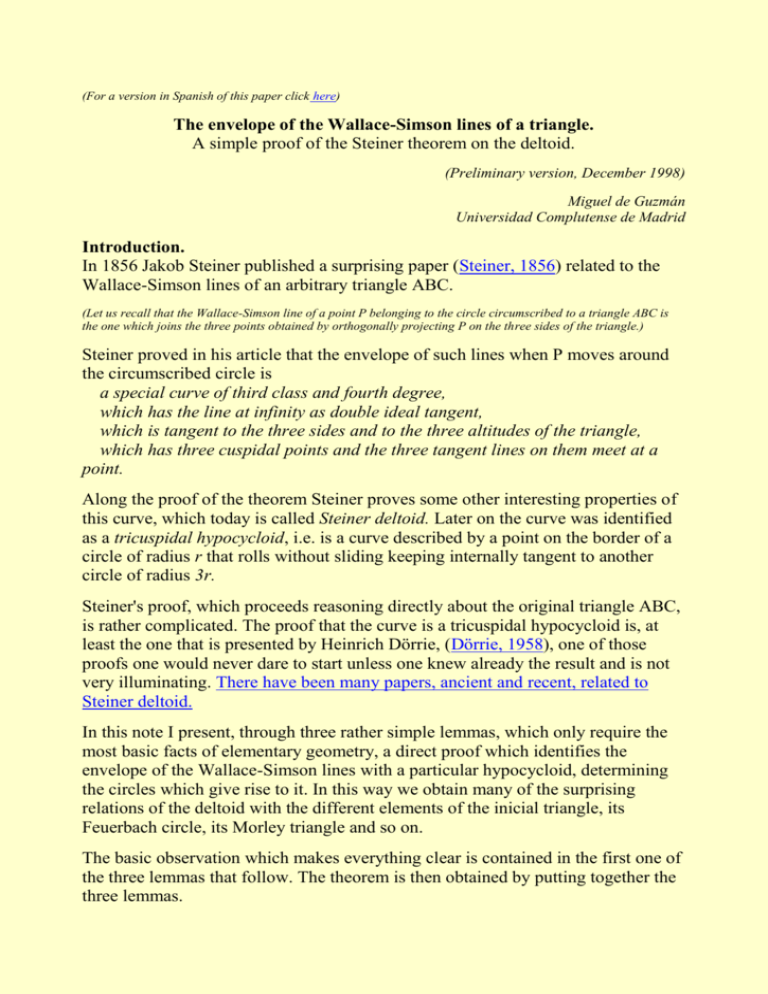Deltoide 8Dic98 - Universidad Complutense de Madrid
advertisement

(For a version in Spanish of this paper click here) The envelope of the Wallace-Simson lines of a triangle. A simple proof of the Steiner theorem on the deltoid. (Preliminary version, December 1998) Miguel de Guzmán Universidad Complutense de Madrid Introduction. In 1856 Jakob Steiner published a surprising paper (Steiner, 1856) related to the Wallace-Simson lines of an arbitrary triangle ABC. (Let us recall that the Wallace-Simson line of a point P belonging to the circle circumscribed to a triangle ABC is the one which joins the three points obtained by orthogonally projecting P on the three sides of the triangle.) Steiner proved in his article that the envelope of such lines when P moves around the circumscribed circle is a special curve of third class and fourth degree, which has the line at infinity as double ideal tangent, which is tangent to the three sides and to the three altitudes of the triangle, which has three cuspidal points and the three tangent lines on them meet at a point. Along the proof of the theorem Steiner proves some other interesting properties of this curve, which today is called Steiner deltoid. Later on the curve was identified as a tricuspidal hypocycloid, i.e. is a curve described by a point on the border of a circle of radius r that rolls without sliding keeping internally tangent to another circle of radius 3r. Steiner's proof, which proceeds reasoning directly about the original triangle ABC, is rather complicated. The proof that the curve is a tricuspidal hypocycloid is, at least the one that is presented by Heinrich Dörrie, (Dörrie, 1958), one of those proofs one would never dare to start unless one knew already the result and is not very illuminating. There have been many papers, ancient and recent, related to Steiner deltoid. In this note I present, through three rather simple lemmas, which only require the most basic facts of elementary geometry, a direct proof which identifies the envelope of the Wallace-Simson lines with a particular hypocycloid, determining the circles which give rise to it. In this way we obtain many of the surprising relations of the deltoid with the different elements of the inicial triangle, its Feuerbach circle, its Morley triangle and so on. The basic observation which makes everything clear is contained in the first one of the three lemmas that follow. The theorem is then obtained by putting together the three lemmas. Lemma 1. Let ABC be an arbitray triangle and K its circumscribed circle. We construct the triangle A'B'C' as Figure 1 shows, inscribed in the same circle K, in such a way that A coincides with A' and with B'C' parallel to BC. Figure 1 Let d be the distance between the two sides BC and B'C'. Let us call v the vector perpendicular to BC and of length d such that the parallel translation determined by v carries the line BC to the line B'C'. Then one has: (1) If P is an arbitrary point of K, then its Wallace-Simson line with respect to A'B'C' is obtained by means of a translation defined by v from the Wallace-Simson line of P with respect to ABC. (Therefore the envelope of the Wallace- Simson lines of A'B'C' is obtained by a parallel translation of vector v from the envelope of the Wallace-Simson lines of ABC.) Proof of Lemma 1(1). (2) The Feuerbach circle (nine-point circle) of the triangle A'B'C' is also obtained from the Feuerbach circle of ABC by the same parallel translation determined by v. Proof of Lemma 1(2). (3) The corresponding sides of the Morley triangles (the triangles determined by the trisector lines ) of ABC and A'B'C' are parallel. Proof of Lemma 1(3). Remark: When B'C' gives rise to a degenerate triangle (because the line B'C' passes through A or because B' coincides with C') and when B'C' stays on the other side of A than BC, the above is valid if we define by continuity the different elements of the statement of the lemma in the cases of degeneration and taking A'B'C' with the same orientation as ABC. Let us call t(A,v) the above defined tranformation that carries the triangle ABC to A'B'C', i.e. the one which keeps fixed the circumscribed circle K, that maintains A=A' and translates BC to B'C' by the translation determined by the vector v. Lemma 2. Let ABC be an arbitrary triangle. Then there exist a transformation t(A,v) that transforms ABC in A'B'C' and another one t(B',v') that transforms B'A'C' in an equilateral triangle B''A''C''. This equilateral triangle has its sides parallel to those of the Morley triangle M of ABC and its orientation is inverse to that of M. Proof of Lemma 2. Lemma 3. For an equilateral triangle ABC the envelope of its Wallace-Simson lines is a tricuspidal hypocycloid whose vertices are the vertices of an equilateral triangle concentric with ABC, with sides parallel to those of ABC and whose size is 3/2 that of ABC. Proof of Lemma 3. THEOREM. Let ABC an arbitrary triangle, K its circumscribed circle, F its Feuerbach circle, and M its Morley triangle. Let R be the length of K. (The radius of F is thus R/2). Then the envelope of the Wallace-Simson lines of ABC is a tricuspidal hypocycloid D concentric with F, tangent to F and such that its three vertices are the vertices of an equilateral triangle T. The sides of T are parallel to those of M and its orientation is inverse to that of M. The circumscribed circle to T has a radius of length 3R/2. (From these facts it becomes clear which are the point and the circles that give rise to D by the rolling motion.) The statement of the theorem simply recapitulates the above lemmas and does not require any further proof. It is also clear from this proof that the deltoid of a triangle ABC can be "determined" from the elements of ABC but its construction with only straightedge and compass is in general impossible, since it is equivalent to the trisection of a general angle. From the lemma 3 above one easily draws another interesting fact: Consider a point P moving on a line p with a harmonic motion of phase s. Attach to the point a straight line forming an angle s/2 with the line p. Then the envelope of all these lines is a deltoid. We leave as an easy exercise the proof of this fact and the precise determination of the main elements of the deltoid. Bibliography. Steiner, Jacob, Über eine besondere Curve dritter Classe (und vierten Grades), Burchardt's Journal Band LIII, 231-237 (Gelesen in der Akademie der Wissenschaften zu Berlin am 7. Januar 1856). Steiner's paper appears also republished in: Steiner, Jacob, Gesammelte Werke, Band II (Herausgegeben von K. Weierstrass) (Berlin, G. Reimer, 1882), 639-647. Dörrie, Heinrich, 100 Great Problems of Elementary Mathematics. Their History and Solution (Dover, New York, 1965). There are many papers related to Steiner's deltoid. One can see below some of them specially interesting ordered by date of publication: Mackay, J. S., Bibliography of the envelope of the Wallace line, Proceedings of the Edinburgh Mathematical Society, 23 (1904-1905), 80-88. Van Horn, C. E., The Simson quartic of a triangle, The American Mathematical Monthly 45 (1938), 434-438. Butchart, J. H., The deltoid regarded as the envelope of Simson lines, The American Mathematical Monthly 46 (1939), 85-86. Patterson, B. C., The triangle: its deltoids and foliates, The American Mathematical Monthly 47 (1940), 11-18. Macbeath, A. M., The Deltoid, Eureka 10 (1948), 20-25. Macbeath, A. M., The Deltoid (II), Eureka 11 (1949), 26-29. Macbeath, A. M., The Deltoid (III), Eureka 12 (1950), 5-6. One can also find interesting information on the web. For example: Xah: Special Plane Curves: Curve Family Index http://www.mirrors.org.sg/curves/SpecialPlaneCurves_dir/Intro_dir/familyIndex.html Deltoid http://www.astro.virginia.edu/~eww6n/math/Deltoid.html MacTutor History of Mathematics Archive http://www-history.mcs.st-andrews.ac.uk/history/Curves/Hypocycloid.html






